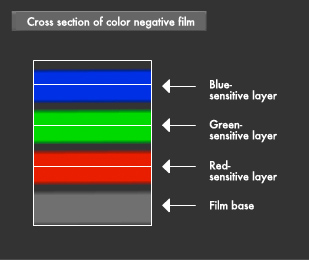- TOP
- The Mysteries of...
- Making Light
- Applications of...
- Light and...

The mechanism of faithfully rendering a picture made by light was first utilized by medieval European artists. However, a giant leap forward was achieved with the invention of film, and photography has continued to evolve into the present-day digital technology.
The light that passes through a tiny hole in a wall creates an upside-down image of the scenery outside on the opposite wall of the room. Medieval European artists would capture such images on their canvases, tracing the details to make accurate sketches.
The word "camera," in fact, derives from "camera obscura," the Latin term that the artists coined for such devices, which they used as an aid to creating their works. "Camera" means "room," while "obscura" means "ambiguous, dark." In short, cameras owe their name to a "dark room."
It was in the first half of the 19th century that photography in the modern sense was born with the discovery of the technique of fitting a camera obscura with a metal plate that had been painted with a light-sensitive silver compound that automatically captured the pinhole image. In time, the metal plate became film, which then evolved from black-and-white to color film. In today's digital cameras, film has been replaced by light sensors that capture images by converting light into digital data.
If light is allowed to enter a darkened room through a tiny hole in a wall or door, the scenery outside will be projected onto the opposite wall. This phenomenon, known as pinhole projection, is one of the basic principles behind photography. The image created by pinhole projection is a reverse image, both upside-down, and left and right reversed. A pinhole camera can be easily created by opening a pinhole in a box that otherwise lets in no light. The hole should be covered with tape, and a sheet of photo printing paper placed inside, opposite the hole, without exposing it to light.

The box should then be pointed in the direction of the scenery to be filmed, and the tape removed from the pinhole to allow light in for a few seconds. If the printing paper is placed in developing solution, the scenery will gradually appear in reverse on the printing paper. Present-day cameras work on the same principle, but with a lens, aperture ring and shutter affixed to the pinhole to adjust focus and light, and film or CCD to replace the wall or printing paper.
Camera film uses silver halides (such as silver chloride, bromide or iodide) as the materials exposed to light. When the silver halide layer absorbs light, electrons within the layer attach to the halide crystals, creating what are known as sensitivity specks. Light accordingly effects chemical changes in the silver-halide layer, leaving a latent image on the film.
When exposed film is placed in a developing agent, the surroundings of the sensitivity specks are converted to silver, as a result of which the exposed areas start to turn black, and the image begins to "be developed."

This is why chemical agents that reduce silver halides to silver are known as "developers." Even with development, those areas not affected by light remain as silver halides. They are removed by placing the film in a different agent that dissolves silver halides, leaving only the black silver grains. This is known as "fixing." A negative, which is an image in which the areas exposed to light appear as shades of black, is thus made by first taking a photo to create a latent image on the film, then developing and fixing that image with chemical agents. If printing paper is placed beneath the negative, and light is shone on the negative, the negative's blackened areas show up as lighter shades. Whiter areas show up as darker shades on the paper when that in turn is developed and fixed. This is the principle of black-and-white photography.
How, then, does color film render color? Color film contains three layers of photo-sensitive emulsion that are sensitive to different wavelengths of light: red, green and blue, respectively. The layer that is sensitive to red light is normally applied first, followed by emulsions sensitive to green light, and then blue light as the topmost layer.
Adding dyes to silver halides makes them sensitive only to specific wavelengths of light. When color film is
exposed, each photosensitive layer absorbs light of a specific wavelength.

Color film contains dye couplers, which, on development and fixation, become yellow, magenta or cyan, the three colors that are complementary to blue, green, and red. This is why a red apple appears green in a color negative. When light is shone through such a color negative onto color printing paper, the yellow, magenta and cyan colors in the negative create complementary colors in the paper, thus recreating the original colors of the subject photographed. This is the principle behind the dye coupler method of creating color images.
In recent years, digital cameras have become increasingly popular as an alternative to cameras that use film. A digital image is a long string of 1s and 0s representing all the colored light dots, known as pixels, which collectively make up the image. Digital cameras employ image sensors, such as CCDs or CMOS sensors, in place of film. CCDs are collections of tiny, light-sensitive diodes that convert light into electrical charges, which are then digitized to create a digital image. Digital cameras, too, work on the principle of filtering the three primary colors of red, green and blue. CMOS and CCD sensors resemble black-and-white film in that they respond only to the strength of light.

In digital cameras, the light beam is split light into its RGB elements before striking the light sensor, which then reads the strength of each color per pixel, and converts that information into digital data. Unlike film, digital images do not deteriorate with age, and can be enjoyed in various ways, such as viewing on a TV or PC screen, or by outputting them using a printer.